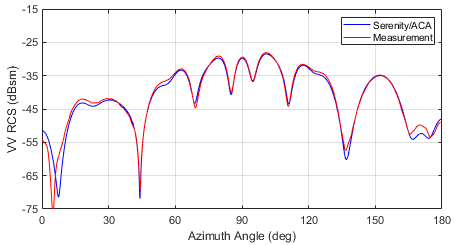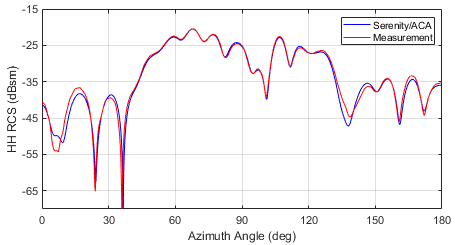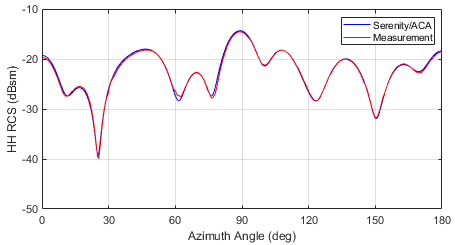
[ Overview |
lucernhammer MT |
Serenity |
Onyx |
Galaxy |
Orion |
Lyra |
Emerald |
Sapphire ]
[ lucernhammer RCS Server |
Benchmark Data |
FAQ |
Ordering Information ]

[ Overview |
lucernhammer MT |
Serenity |
Onyx |
Galaxy |
Orion |
Lyra |
Emerald |
Sapphire ]
[ lucernhammer RCS Server |
Benchmark Data |
FAQ |
Ordering Information ]
UT Austin PRIME Aircraft Benchmarks
On this page are presented simulated RCS for the conducting and dielectric aircraft targets from the Austin Benchmark Suites for Computational Electromagnetics, a publicly available benchmark suite for RCS simulations. The suite is available on github via the following link:
http://github.com/UTAustinCEMGroup/AustinCEMBenchmarks.
The construction and measurement of these aircraft targets wre discussed in detail in the following paper:
J. T. Kelley, A. Maicke, D. A. Chamulak, C. C. Courtney, and A. E. Yilmaz, "Adding a reproducible airplane model to the Austin RCS benchmark suite," in Proc. Applied Comp. Electromagnetics Society (ACES) Symp., July 2020.
as well as several other documents and powerpoint presentations that are available in the benchmark suite.
Some of the simulated data below was also presented previously in Chapter 9 of our book The Method of Moments in Electromagnetics, Third Edition.
The scale aircraft model having a length of approximately 9 inches is considered below. In this case, a suite of meshes, with multiple levels of triangle density, is supplied in the suite, and meshes do not need to be constructed by the user. However, IGES (.igs) files are supplied if the user wishes to do so.
Two aircraft configurations are available: one with closed inlet and exhaust ducts, and another with open ducts. These are illustrated from front and rear angles below.

|

|
| Closed Duct Aircraft Model (front view) | Open Duct Aircraft Model (front view) |

|

|
| Closed Duct Aircraft Model (rear view) | Open Duct Aircraft Model (rear view) |
The aircraft models were 3D-printed in resin, following the same procedure that was outlined for the UT Austin almond benchmark targets, and later coated with conducting paint to create the PEC test cases. The resin is the same used for the almond targets, with permittively values summarized in the table above, as taken from the benchmark. These were entered as-is into the Serenity material summary file.

|
| Resin Permittivity Values |
All calculations below were performed on a Dell Precision T7900 workstation running Ubuntu Linux, with dual twelve-core Intel Xeon CPUs (E5-2690 v3) at 2.6 GHz with 256 GB of RAM, and dual NVIDIA GTX 1080Ti GPUs, each with 12GB of onboard RAM. Serenity utilizes both GPUs.
For the simulated data below, we have selected the "BC" density level meshes for both the closed and open duct aircraft. Finer meshes having densities "CD" and "DD" were also tried but the differences in the RCS versus the "BC" density level were not significant, and they required a much longer run time.
The original meshes have been modified to creat the facet files below. The meshes were rotated, scaled to the appropriate lengths in inches (per the benchmark), and all triangle normals oriented outward.

|

|
| PEC Closed-Duct Aircraft VV RCS, 2.58 GHz | PEC Closed-Duct Aircraft HH RCS, 2.58 GHz |

|

|
| PEC Closed-Duct Aircraft VV RCS, 5.125 GHz | PEC Closed-Duct Aircraft HH RCS, 5.125 GHz |

|

|
| PEC Closed-Duct Aircraft VV RCS, 7.0 GHz | PEC Closed-Duct Aircraft HH RCS, 7.0 GHz |

|

|
| PEC Closed-Duct Aircraft VV RCS, 10.25 GHz | PEC Closed-Duct Aircraft HH RCS, 10.25 GHz |
Compared here is the RCS of the UT Austin PEC Closed-Duct aircraft at 2.58, 5.125, 7.0 and 10.25 GHz. The comparisons are fairly good.
2.58 GHz Data:

|

|
| Solid Resin Closed-Duct Aircraft VV RCS, 2.58 GHz | Solid Resin Closed-Duct Aircraft HH RCS, 2.58 GHz |

|

|
| Solid Resin Closed-Duct Aircraft VV RCS, 5.125 GHz | Solid Resin Closed-Duct Aircraft HH RCS, 5.125 GHz |

|

|
| Solid Resin Closed-Duct Aircraft VV RCS, 7.0 GHz | Solid Resin Closed-Duct Aircraft HH RCS, 7.0 GHz |

|

|
| Solid Resin Closed-Duct Aircraft VV RCS, 10.25 GHz | Solid Resin Closed-Duct Aircraft HH RCS, 10.25 GHz |
Compared here is the RCS of the UT Austin Solid Resin Closed-Duct aircraft at 2.58, 5.125, 7.0 and 10.25 GHz. The comparisons are fairly good.
2.58 GHz Data:

|

|
| PEC Open-Duct Aircraft VV RCS, 2.58 GHz | PEC Open-Duct Aircraft HH RCS, 2.58 GHz |

|

|
| PEC Open-Duct Aircraft VV RCS, 5.125 GHz | PEC Open-Duct Aircraft HH RCS, 5.125 GHz |

|

|
| PEC Open-Duct Aircraft VV RCS, 7.0 GHz | PEC Open-Duct Aircraft HH RCS, 7.0 GHz |

|

|
| PEC Open-Duct Aircraft VV RCS, 10.25 GHz | PEC Open-Duct Aircraft HH RCS, 10.25 GHz |
Compared here is the RCS of the UT Austin PEC Open-Duct aircraft at 2.58, 5.125, 7.0 and 10.25 GHz. The comparisons are fairly good.
2.58 GHz Data: